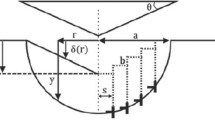Abstract
The phenomenon of apparent microhardness increase with increasing applied indentation test load, the reverse indentation size effect (RISE), was addressed from the viewpoint of indentation-induced cracking. The apparent microhardness when the cracking occurs was found to be related to the applied indentation test load as P 5/3. Previously published results on single crystals of silicon, GaAs, GaP and InP, which differ by a factor of four, all fall on the same line when analysed through this concept. It is concluded that the RISE is a result of the specimen cracking during the indentation.
Similar content being viewed by others
References
H. Li and R. C. Bradt, J. Mater. Sci. 28 (1993) 917.
H. Li, A. Ghosh, Y. H. Han and R. C. Bradt, J. Mater. Res. 8 (1993) 1028.
H. Li and R. C. Bradt, Mater. Sci. Eng. A142 (1991) 51.
Idem, J. Hard Mater. 3 (1992) 403.
Idem, J. Non-Cryst. Solids 146 (1992) 197.
Idem, J. Diamond Rel. Mater. 1 (1992) 1161.
P. Feltham and R. Banerjee, J. Mater. Sci. 27 (1992) 1626.
R. Banerjee and P. Feltham, ibid. 9 (1974) 1478.
B. R. Lawn and A. G. Evans, ibid. 12 (1977) 2195.
J. Lankford and D. L. Davidson, ibid. 14 (1979) 1662.
B. R. Lawn and M. V. Swain, ibid. 10 (1975) 113.
B. R. Lawn and E. R. Fuller, ibid. 10 (1975) 2016.
R. Nowak, K. Ueno and M. Kinoshita, in “Fracture Mechanics of Ceramics, Vol. 10, edited by R. C. Bradt, D. P. H. Hasselman, D. Munz, M. Sakai and V. A. Shevchenko (Plenum Press, New York, 1992) p. 155.
R. B. Lawn and R. Wilshaw, J. Mater. Sci. 10 (1975) 1049.
I. N. Sneddon, Int. J. Eng. Sci. 3 (1965) 47.
B. R. Lawn and V. R. Howes, J. Mater. Sci. 16 (1981) 2745.
I. J. McColm, in “Ceramic Hardness” (Plenum Press, New York, 1990) Ch. 3, p. 145.
M. Sakai, Acta Metall. Mater. 41 (1993) 1751.
M. Atkinson and H. Shi, Mater. Sci. Technol. 5 (1989) 613.
D. R. Tate, Trans. ASM 35 (1945) 374.
Author information
Authors and Affiliations
Rights and permissions
About this article
Cite this article
Li, H., Bradt, R.C. The effect of indentation-induced cracking on the apparent microhardness. JOURNAL OF MATERIALS SCIENCE 31, 1065–1070 (1996). https://doi.org/10.1007/BF00352908
Received:
Accepted:
Published:
Issue Date:
DOI: https://doi.org/10.1007/BF00352908




